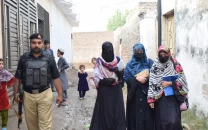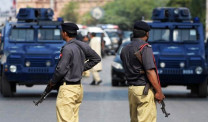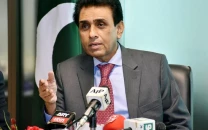Hot and bothered: Karachi braces for a sweat-soaked Eidul Fitr
Met Office predicts extreme hot weather to persist as mercury climbs to record high

If anyone has spent the past week in Karachi and experienced the mercury’s rise firsthand, they shouldn’t need a news story to tell them that the port city is boiling.
The much-loathed harbingering came on the eve of April 30th, when the city turned into a furnace and recorded its hottest day of the season.
The Metrological Department later announced that the hot and dry weather will likely linger for the rest of the week, issuing a public advisory for a heat spell and putting a damper on the spirits of those ready to make the most of their Eid holidays.
“It had been two years since we really celebrated Eidul Fitr in full swing. So this year, with the pandemic restrictions removed, we were hoping to utilise our holidays to go on a fun excursion with the family but not anymore. It’s too hot to even consider stepping out of the house,” expressed Fariyal, a local housewife who had been looking forward to an eventful Eid.
Whereas, Amber, who is another housewife from the megacity, has been on tenterhooks about the city’s load-shedding situation. “It’s already too hot, the government should consider curbing power outages at least while we are under a heat spell,” she said fearing a sweaty rather than sweet Eid.
It ‘feels like’ hell
However, it’s not just Karachi that is experiencing unprecedented levels of heat early into summers this year, but rather much of the Sindh province.
While the mercury has already started crossing the 40°C mark in most places, the people have reportedly been feeling hotter than the recorded temperature.
Per Karachi University Institute of Space and Technology’s representative Dr Naeem Sadiq, this is because the international standards for measuring the effects of heat on the human body suggest that the temperature felt by the human body -called the Feels Like temperature- can surge to upwards of 44°C during the months of May and June in Karachi. In the recent past, some areas of Sindh have also recorded the heat index and effects of heat on human skin to be equivalent to 54°C.
“In such circumstances, the sweat does not dry out due to excessive humidity in the air, which leads to a higher probability of developing skin and eye diseases during this season,” warned Dr Sadiq.
Arrangements in healthcare
Following the meteorological department’s alert that hinted at a possible heatwave on the horizon, the provincial health department has declared an emergency in all public hospitals, cancelling employees’ petitions for leaves.
In addition to that, the Sindh Health Services’ Director-General has also directed to ensure access to various facilities including 24-hour emergency services and ambulances in government hospitals across Sindh.
“The number of medical and paramedical staff in hospitals been increased, while. special wards for heatstroke patients will be set up soon,” informed a government source privy to the matter, adding that awareness campaigns to prevent heatstroke are also in the works.
However, per Jinnah Hospital’s former Executive Director Dr Seemi Jamali, while the government’s doing the most it can, heatstroke has a severe mortality rate and death is inevitable. “It is possible to treat a patient with heat absorption, but once a person has a heatstroke, the affected person barely has a chance of survival.
Heatstroke patients die even in the best facilities,” she informed. Highlighting precautionary measures Dr Jamali said that the best way to avoid heatstroke is avoid going out in the sun unnecessarily and stay hydrated. “People should eat light food and consume yogurt as much as they can,” she told.
A concrete issue
While on the other hand, Environmentalist Yasir Hussain believes that the fault lines in city planning are also to be blamed for extreme heat. He says that Karachi needs an integrated master plan at this time; one that curbs unregulated construction of high-rises in the city.
“When tall buildings are built, they absorb more heat, and then the same heat is emitted by the buildings. It also makes a difference. Thus the natural heat is intensified by the concrete. If buildings are directly exposed to the sun’s heat they can be given a green cover, so the buildings don’t emit heat.
If the colour of the buildings is dark, then the heat will increase so they should be painted in light tones, while the use of air conditioners should also be reduced,” he told The Express Tribune adding that exiting buildings cannot be deconstructed but going ahead, these points should be made part of the masterplan and enforced in urban development.



















COMMENTS
Comments are moderated and generally will be posted if they are on-topic and not abusive.
For more information, please see our Comments FAQ